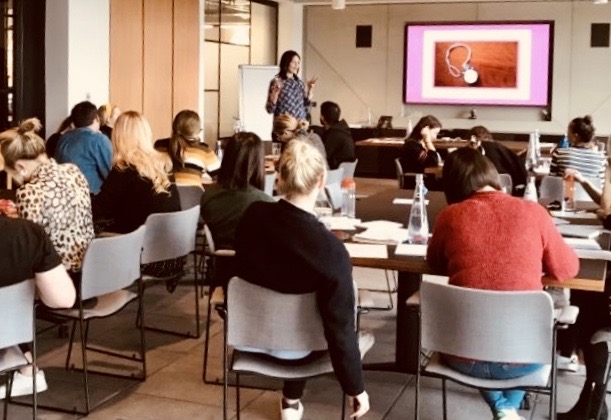Take a moment to consider what qualities you notice in yourself when you communicate at your best. Are you: Calm? Concise? Clear? What about a good listener?
I’m Tamson. I am an Insight Coach, Speaker and Trainer for PUSH, specialising in psychological skills and leadership. In the second of this Leadership Blog Series, I share how a simple coaching techniques used daily can get the best out of your team and your colleagues.
Have you read the first Leadership series blog: How to lead with direction and purpose?
What are your leadership qualities?
In my work with team leaders, directors and CEOs, I ask them about their leadership qualities. I am always happy to hear of great communication skills, though listening is rarely mentioned. Yet it is the most important skill for successfully interacting with your team and your colleagues.
Think about a time that required you to phone a call centre. Remember how the customer service representative read through their script and kept asking you irrelevant questions, forcing their process on you? How frustrated did you feel when they would not listen to your problem or take the time to understand what you needed?
In the book, The Chimp Paradox, Professor Steve Peters labels the emotionally reactive part of the mind our ‘inner chimp’, and the executive, thinking part as the ‘human’. That call centre exchange triggered your chimp. We talk about ‘the chimp being on the move’ when we are upset, disappointed or confused. We think emotively, jump to conclusions, and fixate on what we perceive to be the problem. We lose focus, we make mistakes and our interactions with others suffer. Effective leaders work to settle the chimp in others and wake up the more performant human.
Truly listening
Our chimps core need is to be heard, acknowledged, and – at best – reassured. In the absence of such a response, it will actively keep the problem alive until someone finally listens. Once it achieves this, it relaxes and allows the ‘human’ back into the driving seat.
We can see this process in MRI scans. Chimp behaviour correlates with high blood flow to the emotional core of our brain, the amygdala. Being heard and acknowledged redirects the blood to the prefrontal cortex, associated with higher human functioning. Receiving advice and practical suggestions to a problem while the chimp is actively on the move does not help. Feeling heard is what causes this shift in blood flow. Only then can a different perspective emerge and the problem moved on.
You might not feel you have time to truly listen if you are yourself feeling overwhelmed with your own to-do list or problems. It can be tempting to redirect them, shut them down, or avoid them. This is a literal waste of time, as your colleague’s chimp will continue looking for someone who can listen. Plus, if you are their line manager, you probably are the right person for them to be asking for support.
Allowing your colleague 2-3 minutes to exercise whatever is bothering them – actively, and not with half an eye on your laptop – shows them that you are listening. That is all they need for their chimp to feel acknowledged and for their blood to flow back to the prefrontal cortex where you want it.
To really nail this process, paraphrase back what your colleague shared, and actively confirm that you have heard them. This will de-escalate even a very stressed chimp. Try:
- “Can I just check that I have understood the problem…” (and paraphrase)
- “What I have heard is…” (and paraphrase)
Reassure your colleague’s chimp that you empathise, whatever the issue. “That sounds tough/difficult” will melt the chimp right in front of your eyes.
This may sound simple. However, only the human properly listens. Chimps do not; they have their fingers in their ears! So to listen effectively you must also manage your own chimp. First, you need to notice when your own chimp is on the move. Top tip: if you cannot effectively paraphrase, you are likely in your chimp.
Hitting the pause button
Next, hit the pause button! Whatever you were thinking or feeling, do not invest further in it. Do not say anything for a moment. You need to actively redirect yourself back into your own human. You can do this effectively if you deliberately focus on what you are hearing and ‘drop into listening mode’. You can respond out loud again when you can hear yourself paraphrasing your colleague effectively in your own mind. In the meantime, maintain an attentive body language as best you can.
A catch is that our chimp can become actively overwhelmed by listening if we perceive that we are just being given more problems (to add to our ongoing to-do list) which our team members ought to be resolving.
This is where further coaching skills come in. Differentiating between directing or facilitating your team is a great skill to empower team members to develop confidence and skill in their work. Knowing when and how to switch between the two can be an invaluable skill and will make the difference to a colleague’s chimps being onboard – allowing their human to get on with their best work.
PUSH help create leaders who are living, breathing examples of excellence. Who are confident and capable, who listen and value their team members and allow them the opportunity to grow and develop beyond what they thought they were capable of. To find out more, please get in touch.

more articles by Cate Murden

